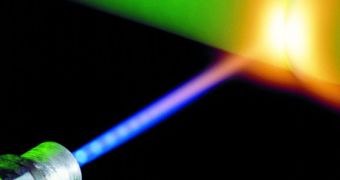Researchers from the Yokohama National University, in Japan, say they have been studying the possibility of integrating photonic nanolasers and photonic integrated circuits on photonic crystals, in order to improve the efficiency of photonic nanolasers, and claim to have successfully created photonic crystal nanolasers monolithically integrated by implying a passive waveguide to increase effective light extraction.
Toshihiko Baba explains that the light extraction efficiency can be highly increased by using a nanolaser integrated with the use of passive waveguides, through a procedure commonly known as the MOCVD butt-joint technique. This represents an important step in the development of photonic nanolaser and photonic integrated circuits. Furthermore, the research team has also been experimenting with single photon emitters that could provide quantum cryptography procedures, which could be used in the manufacturing of the next generation of RAM modules, or even for bio-chemical probing.
The only problem is that, for now, nanolaser integration remains out of practical reach. Most of the time, people prefer to use lasers with improper characteristics, due to lack of technology, determining leaky light or evanescent coupled light just to make use of the available fiber optic devices.
The problems with light extraction experienced today will be solved sooner or later, but for the time being, Baba admits that in his experiments the improvements in efficiency were rather low, measuring only four percent performance enhancement. This is mostly due to the fact that they have been using lensed taper fiber with optimized waveguide facet, both notorious for their extrinsic problems, which if solved could provide with an efficiency ten times higher than that obtained in the current experiment.
The results obtained at the Yokohama National University have already been tested in a waveguide type laser. Baba also claims to have demonstrated that, by using integrated photonic nanolaser, they have been able to prove that resonant photopumping effects can be obtained. The new findings detailed by Baba promise a bright future for the photonic integrated nanolasers, despite the fact that multiple difficult challenges still lie ahead. The technology to integrate photonic nanolasers stands at our fingertips, all we have to do is improve it, in order to reach an efficiency comparable to that of conventional lasers.

 14 DAY TRIAL //
14 DAY TRIAL //